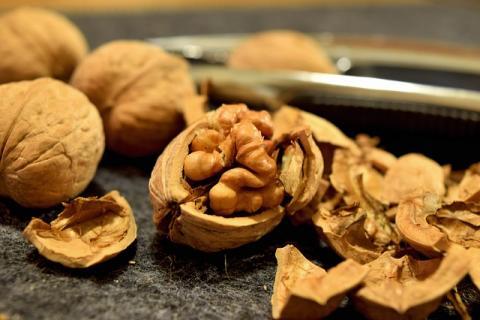
The walnut tree is found from the Balkans to China. It is a slow-growing tree, and its fruit has been eaten by Europeans for more than 8,000 years. The ancient Greeks began cultivating the trees and the practice spread throughout Europe. The walnut tree came to North America with the English settlers in the early 19th century – and thus the walnut got its name the English walnut. Today the largest groves of walnut trees are found in Kyrgyzstan at high elevations. The walnut tree has a broad crown originating from a short trunk and takes several years to produce fruit. Walnuts are brain shaped with a hard shell and the meat is rich in nutrients with a less than sweet taste. Ayurveda suggests walnuts for Vata personalities while Pitta and Kapha doshas should avoid eating them. Holistic healers have taken up the Ayurveda uses of walnuts in treating many illnesses and to help maintain a healthy body.
Walnuts are one of the most nutritious of nuts that are high in protein and contain many vitamins and minerals. Found in walnuts are unsaturated fat and carbohydrates that include dietary fiber. They also contain thiamin, vitamin B6, folate, manganese, copper, magnesium, phosphorus, potassium, calcium, zinc and iron. This nutritional content makes them an excellent aid to good health.
Here are 5 more reasons to add more walnuts to your diet:
1. Walnuts benefit cardiovascular health by lowering the risk of blood clotting because the nutrients in walnuts provide the body with a clean vascular system. This ensures the optimum function of veins and arteries and maintains a steady blood pressure; this is conducive to healthy heart function and reduces the risk of stroke.
2. For a nutritious addition to a weight loss diet, walnuts aid in curtailing cravings for unhealthy snacks. They contain approximately 690 calories per 100 grams and are filling, since they are so high in fiber and protein. The nutrients satisfy the need for larger meals so a half of a cup of walnuts before eating will reduce the desire to eat more food.
3. Preventing cancer is another benefit of adding walnuts to the diet. Consuming approximately one-quarter cup of walnuts a day reduces the risk of prostate and breast cancers. Studies have proven that those who added walnuts to their diet slowed tumor growth in half in breast cancer and reduced the growth of prostate cancer by up to forty percent.
4. Walnuts have a substantial amount of antioxidants. These substances contribute to many positive health benefits like slowing down the aging process by reducing the free radicals, which cause system deterioration. Studies have shown that walnuts help to reduce chemically-induced liver damage.
5. Walnuts are a food that significantly improves the health of sperm like its quality, vitality and motility, the movement of the sperm. It is also beneficial to sperm morphology or structure. Walnuts are beneficial to brain health with high amounts of vitamin E, folate and melatonin; this provides increase in inferential reasoning in young adults. Walnuts also reduce the fasting insulin levels in those who have type-2 diabetes.
There are many recipes that use walnuts for dessert; they are a main ingredient in baklava and make a delicious addition to salads.
Vegetarian Lasagna
9x13 oblong baking pan
Pre-heated oven to 350 degrees F
Approximate servings: 12
Ingredients
1 package Lasagna noodles, cooked to al dente
½ cup Ricotta cheese
½ cup Mozzarella cheese
½ cup Scamorza cheese
½ cup Provolone cheese
1 bunch Spinach, fresh
2 cups Walnuts, whole
2 cups Tomato sauce
1 ½ teaspoons Oregano, dried
1 teaspoon Marjoram, dried
1 teaspoon Thyme, dried
½ teaspoon` Basil, dried
½ teaspoon Rosemary, dried
½ teaspoon Sage, dried
½ teaspoon Garlic granules
½ teaspoon Onion granules
1 teaspoon Salt
½ teaspoon Pepper
Directions
1. Place the tomato sauce in a medium mixing bowl; blend in all of the seasonings and the salt and pepper.
2. Spread about ½ a cup of the seasoned sauce on the bottom of the baking pan.
3. Add on a layer of lasagna noodles.
4. Cover the lasagna noodles with ¼ cup of each of the cheeses, and spread evenly.
5. Cover the cheeses with a double layer of spinach.
6. Sprinkle a layer of walnuts over the layer of spinach.
7. Spread about ½ a cup of the seasoned sauce on over the layer of walnuts.
8. Repeat steps 3 through 7.
9. Bake for ½ an hour or until all of the cheese is melted.








